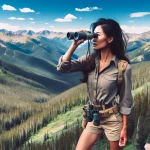Colorado is renowned for its breathtaking mountain vistas, abundant outdoor recreation, and dynamic weather spanning all four seasons. The state’s climate brings a unique appeal, from winter wonderlands ripe for skiing to sunny summer days perfect for hiking and wildlife viewing. This article explores Colorado’s one-of-a-kind weather patterns across destinations like Denver, Colorado Springs, and Boulder while detailing how the state’s shifting seasons offer travelers boundless opportunities for adventure.
In This Article
TL;DR
- Colorado has highly variable weather with strong seasonal differences influenced by the Rocky Mountains.
- Key destinations like Denver, Boulder, and Colorado Springs each have distinct temperature averages, precipitation patterns, and microclimates.
- The state's seasonal changes unlock different outdoor activities – from epic skiing in winter to hiking among wildflower blooms in spring.
- Weather impacts most aspects of travel in Colorado, from photography conditions to road closures, requiring flexible plans.
- Climate change is altering Colorado's weather, with hotter summers and declining snowpack levels in some areas.
Seasonal Shifts Across the Centennial State
Blanketed by the soaring Rocky Mountains, Colorado weather is a study in extremes. The state toggles between sun-drenched summers and snowbound winters, with fall and spring bringing their own charms through vibrant foliage and wildflower displays. These seasonal changes allow for a spectrum of weather-dependent activities to enjoy across the year. In the Denver area, the National Weather Service often reports snow showers and high winds, especially in higher elevations, while Colorado Springs and the southern Colorado regions may experience milder weather conditions.
The weather in Denver can vary significantly within a day, with current conditions often including sunsets that illuminate the stunning photos characteristic of Colorado’s diverse climates. The current weather often reflects the dynamic interplay of clouds, wind, and changing temperatures, essential information for both meteorologists and the public.
Winter Wonders
For skiers and snowboarders, Colorado winters are the stuff of dreams. The ski season typically runs from late November through April, with many resorts located high in the mountains receiving over 300 inches of light, dry powder. Storm cycles blanket peaks like Vail, Aspen, and Breckenridge in fresh snow, while longer sunny spells create a perfectly packed powder. Chilly mountain temperatures, sometimes dropping below 0°F, enhance the winter wonderland ambiance.
Lower elevations also experience cold winter temperatures, averaging highs in the 40s°F, along with regular snowfall. Cities like Denver and Colorado Springs average about 56 and 42 inches of snow per winter, respectively. Boulder gets even more snow at nearly 80 inches annually. While snowfall fluctuates year to year, Colorado’s winter chill and snowy landscapes offer prime conditions for skiing, snowshoeing, and ice climbing from late fall through early spring.
Spring’s Renewal
March through May heralds Colorado’s spring season, as temperatures steadily rise and snow starts melting even in the high country. Daily highs reach into the 60s°F across Denver, Boulder and Colorado Springs by April, making for pleasant weather to get outdoors. By May, highs can hit 80°F on warmer days.
Spring showcases Colorado’s natural beauty, with wildflowers like columbines and Indian paintbrushes blanketing mountain meadows. Aspen groves burst into bright greens, and wildlife like bears, elk, and bighorn sheep emerge with their young after-winter dormancy. Popular spring activities include hiking, mountain biking, climbing, photography, and wildlife viewing. Despite milder temperatures, late spring snowstorms can still sweep across the mountains.
Summer Heat
Summer kicks off in June, bringing abundant sunshine and rising mercury levels. June through August are Colorado’s warmest months, with temperatures in Denver and the Front Range cities spiking into the 80s and 90s°F many days. The mountains remain cooler, with highs in the 70s and 80s°F, but warmer than in other seasons.
Colorado summers unlock even more outdoor recreation like camping, fishing, rafting, and paddleboarding on the state’s picturesque rivers and alpine lakes. Summer also brings a chance for afternoon thunderstorms that build over the mountains, so weather awareness is key. With abundant sunshine and moderate temperatures at higher elevations, summer is ideal for hiking Colorado’s many mountain trails and enjoying vistas bursting with wildflowers and greenery.
Fall Foliage
Autumn in Colorado serves up pleasant weather along with dazzling fall colors. September and October see high temperatures in the 60s and 70s°F across most of the state, making for crisp days and cool evenings. By late October, nighttime temps can dip below freezing.
Aspens display golden hues from mid-September through early October during peak foliage season, cloaking mountainsides and valleys in eye-catching yellows. Other trees like scrub oak and Gambel oak add splashes of red and orange to the landscape. Popular fall activities include hiking to capture the colorful scenery along with biking, horseback riding, and wildlife viewing. The first snows typically start falling across the high country in October.
Regional Weather Variances
While all of Colorado sees seasonal weather shifts, key destinations have their own distinct climate profiles worth noting when planning travel activities.
Denver – Sunny and Semi-Arid
Sitting at the base of the Front Range at 5,280 feet elevation, Denver enjoys a semi-arid climate with abundant sunshine. Its average high temperatures range from 44°F in January up to 90°F in July. With precipitation averaging just 15 inches annually, Denver has a relatively dry climate apart from summer thunderstorms. However, the “Mile High City” still averages 56 inches of snow per winter. Denver’s sunny weather and mild temperatures for much of the year make it a popular basecamp for Front Range and mountain adventures. It shares Denver’s semi-arid climate but has cooler year-round temperatures, stronger winter storms, and more precipitation. Snowfall averages almost 80 inches per winter, enhanced by its foothills location. Boulder only sees about 300 sunny days annually and averages nearly 20 inches of precipitation, including spring snow. Its unique microclimate supports outdoor activities through all seasons yet requires extra winter preparedness.
Colorado Springs – Crisp Mountain Climate
Sitting at the base of Pikes Peak, over 6,000 feet above sea level, Colorado Springs has a cooler mountain climate with low humidity. It averages around 300 sunny days per year but also sees temperature extremes, from average January lows below 20°F up to average July highs approaching 85°F. Drier than Denver, its annual precipitation averages just 15 inches, though with 42 inches of snow. At higher elevations than Denver or Boulder, Colorado Springs tends to experience extreme winter weather conditions, from bitter cold to paralyzing blizzards.
Outdoor Adventure Across All Weather
Beyond marveling at awe-inspiring vistas, one of Colorado’s biggest draws is the wealth of outdoor recreation readily accessible across seasons – thanks largely to the state’s diverse weather and terrain. Certain activities like skiing and snowboarding require winter snows, while others like rafting and fishing depend on spring runoff. But the following adventures can be enjoyed year-round with proper preparation.
Hiking and Backpacking
From Rocky Mountain National Park to the Colorado Trail, hiking opportunities abound across the state. Summer and fall offer mild temperatures for extended backpacking trips, with the added bonus of vibrant wildflower displays in July and August. Lower elevation trails generally remain accessible year-round, though snowshoes or traction devices are essential for winter and spring hiking. No matter the season, hikers should monitor weather reports for storms and temperature extremes.
Mountain Biking
Another popular way to soak up Colorado’s scenery is on two wheels. From lift-served downhill runs to scenic cross-country routes, mountain biking provides an adrenaline rush across variable terrain. While summer and early fall provide the longest riding seasons, fat-tire bikes enable winter riding. Spring mountain biking means contending with mud and wet trails. Riders should prepare for rapid weather changes at higher elevations.
Rock Climbing and Mountaineering
Colorado’s sheer cliff faces and towering peaks offer bountiful rock climbing and mountaineering opportunities. But these technical sports require close weather monitoring before setting out. While summer’s mild temperatures are ideal, afternoon thunderstorms can develop suddenly and bring lightning, hail, and high winds. Spring and fall offer stable weather, but nighttime cold intensifies at altitude. Only advanced mountaineers attempt winter ascents, using specialized gear to handle extreme avalanche risks and erratic blizzards.
Fishing and Rafting
Anglers flock to the state for its blue-ribbon trout streams and reservoirs brimming with kokanee salmon, bass, and pike. Spring runoff swells rivers with snowmelt, kicking the rafting season into high gear. By summertime, flows stabilize, creating prime fishing conditions that last into fall. Winter fishing and rafting opportunities are limited, but hardy anglers can ice fish. With fishing and rafting so dependent on snowpack and runoff, climate change poses challenges in the coming decades.
Wildlife Viewing
From bighorn sheep to black bears, moose to mountain goats, Colorado is a wildlife haven. Winter drives spot herds of elk and deer at lower elevations. Spring welcomes animal babies, with good sightings into summer. Fall breeding seasons also increase roadside creature sightings. The best wildlife viewing hinges on weather limiting human activity like snowfall keeping crowds away. Quiet snowshoe hikes often yield the most wildlife viewings.
Photography Shines in Colorado Light
With its breathtaking mountain vistas and golden light, Colorado is a landscape photographer’s dream. However, the state’s variable weather and elevation extremes add challenges. Photographers must carefully consider seasons and locations to capture stunning images.
Crisp winter days create picture-perfect snowscapes across the high country, ideal for mountain and ski town shoots. Denver, Boulder, and Colorado Springs also make appealing winter subjects framed by snowy foregrounds and backgrounds. Photographing winter wildlife and mountain adventurers like ice climbers and backcountry skiers tell compelling seasonal stories.
Vibrant spring wildflowers create an eye-catching contrast against remnants of snowfall at higher elevations in May and June. Pristine Mountain Lakes shimmer in postcard-worthy shots this time of year as well. Photographing spring wildlife babies and overflowing rapids also yields dynamic images.
Colorado’s golden hour really shines from July through September, casting a warm glow over summer mountain landscapes. Photographing alpine wildflower meadows, winding trails, and cascading waterfalls illuminated by the low afternoon light creates magical results. Crisp mornings and evenings provide ideal shooting times in summer.
Blazing aspens and other fall foliage make exceptional September and October subjects, especially with a dusting of snow or foreground evergreens. Open parks filled with golden trees contrast beautifully with the rugged Rockies looming in the distance. Even into November, lower elevation destinations like Denver and Colorado Springs continue providing good photography conditions.
Climate Change Alters Weather Patterns
While Colorado’s varied topography has always created an amalgam of microclimates, human-caused climate change is now impacting weather across the state. According to NOAA climate data, temperatures across Colorado have already warmed by 2°F over the past 30 years compared to the 1901-1960 average. The last decade has trended even warmer.
Climate experts forecast Colorado could warm by another 2.5°F to 6°F by 2050 if global emissions stay high. This will make summers even hotter, with more frequent, intense heat waves increasing wildfire risks. Warming is also projected to reduce Colorado’s snowpack, which feeds rivers and reservoirs. With the state’s economy and lifestyle so intertwined with snow and water resources, declining snowpack poses challenges.
At the same time, climate change may enhance extreme weather events like severe thunderstorms and heavy rainfall. Combined with earlier snowmelt, this could heighten spring flooding. The complex combination of warming and weather extremes shows why reducing emissions is crucial for Colorado’s future.
Preparing for Colorado’s Climate
To make the most of a Colorado vacation across seasons, advanced weather preparation and planning is key. Travelers should pack clothing layers that can handle 30-degree temperature swings in the mountains. Quick-drying and moisture-wicking fabrics also prove useful. Since afternoon thunderstorms often flare up in summer, carrying lightweight rain jackets is wise.
In winter and shoulder seasons, packing according to the forecast is especially critical. Bring snow boots and traction for likely snow days, along with extra socks and gloves. Always check road conditions and be prepared to adjust travel plans around winter storms. Whether hitting the slopes or trails, carrying emergency gear like flashlights, first aid kits, and firestarters can prove lifesaving if conditions deteriorate unexpectedly.
Travelers should also monitor weather alerts through resources like local news and the National Weather Service. Smartphone apps providing hourly forecasts and winter driving advisories also help visitors stay abreast of changing conditions. By planning activities based on the most current weather insights, travelers can safely experience Colorado’s glorious – yet at times unpredictable – great outdoors.
FAQ
What is the best time of year to visit Colorado for nice weather?
While Colorado sees pleasant weather from May through October, the state truly offers ideal conditions for outdoor activities across all four seasons. Summer (June-August) boasts warm temperatures and long sunny days, while fall (September-October) shines with vibrant foliage. Spring (April-May) showcases wildflower blooms and wildlife babies emerging, while winter (November-March) transforms the Rocky Mountains into a snow-covered paradise perfect for skiing.
What type of clothing is best for Colorado’s variable weather?
It’s wise to pack layers when visiting Colorado, allowing you to adjust to the state’s dramatic elevation and temperature extremes.






